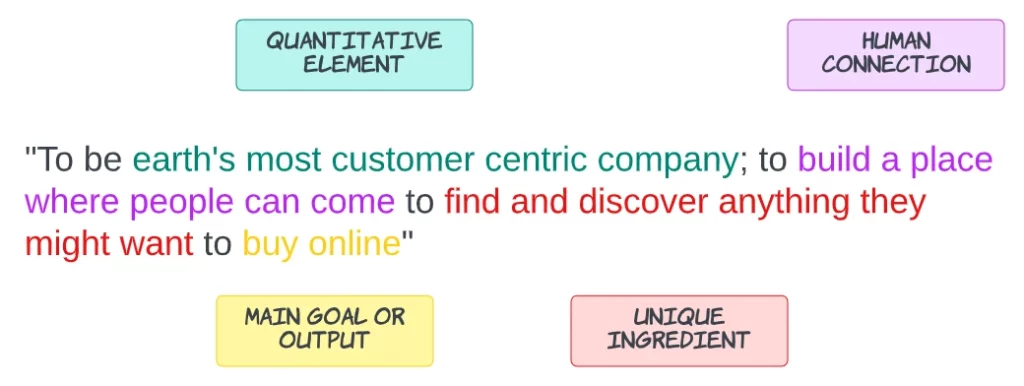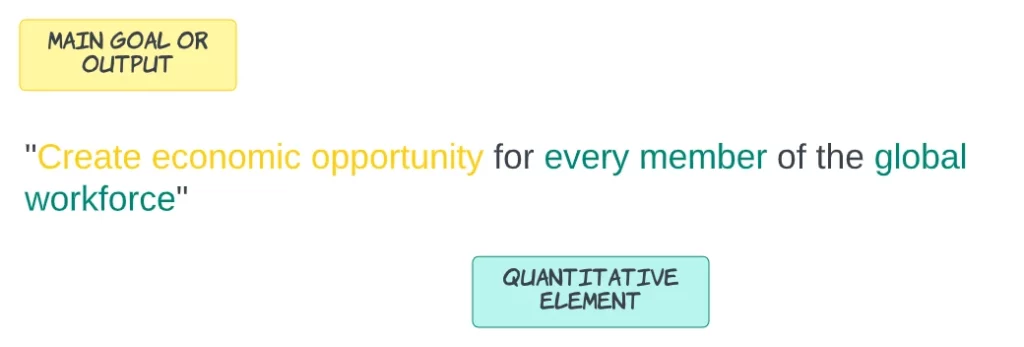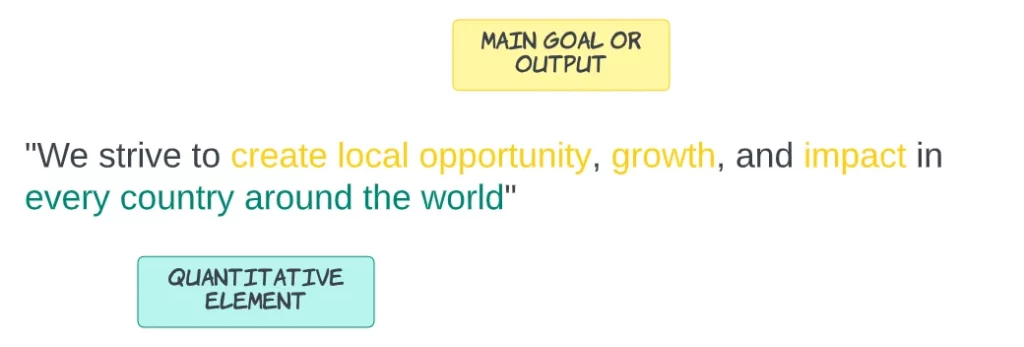In brief:
When you’re working on a product, it’s important to have a clear vision of what you want the product to be. This is especially true for product teams – without a clear vision, it can be difficult to agree on priorities and make decisions. That’s why every team should have a product vision statement. In this blog post, i’ll explain what a product vision statement is, how writing a product vision statement can be broken down into four key components and some product vision examples to get ideas and inspiration for you and your team!
Table of content:
- What is a product vision statement and why do you need one?
- What is the difference between a vision statement and a mission statement?
- How to write a product vision statement that inspires your team
- Examples of great product vision statements
- How to get buy-in from your team
- Tips for keeping your product vision statement up-to-date
What is a product vision statement and why do you need one?
It can be hard to keep everyone on your team aligned and working towards the same goal. You need to make sure that everyone is on the same page, and that they understand what needs to be done. If there are any problems, you need to address them immediately and in a coherent way. Without a clear vision, it’s easy for people to get sidetracked and start working on priorities that are not taking the product forward, it can be difficult to maintain focus and avoid common pitfalls such as scope creep and feature creep. This can lead to wasted time and energy, and can ultimately hurt the product as a whole.
Creating a strong product vision statement is one of the most important steps in product development. A vision statement articulates the long-term goals of a product, providing a clear and inspiring direction for all those involved in its development. A good product vision statement should be achievable, measurable, and relevant to the company’s overall strategy. By taking the time to craft a compelling product vision statement, you can set your product up for success.
What is the difference between a vision statement and a mission statement?
There’s often confusion over the difference between a vision statement and a mission statement. A mission statement defines the purpose of a company, organisation or product, while a vision statement describes the desired future state. In other words, a mission statement is focused on the present, while a vision statement looks to the future.
Some companies will have both a mission and vision statement, while others just have one or the other. But whether you have one or both, it’s important that they are well-defined and aligned with your strategic goals. Your mission and vision statements should be clear, concise and inspiring – they should give your employees and customers alike a sense of what you’re trying to achieve and why you’re doing it. If you can communicate your mission and vision effectively, you’ll be well on your way to achieving your goals.
How to write a product vision statement that inspires your team
The product vision should be short, clear, and inspiring, something that gets everyone on your team excited about the product they’re working on. There’s no one right way to write a product vision statement, but below are the steps that I take when beginning this process.
What are the steps for creating a product vision?
The first step is to come up with a clear and concise statement of the product’s purpose. What is the product supposed to do, and why is it important?
Next, you should focus on the future. What are your goals for the product, and what do you want it to achieve? What are the ultimate outcomes you’re hoping for?
Finally, you need to think about what makes your product unique. What sets it apart from other products in the market, and why should people care about it?
Once you’ve got all of that down, you can start to put together your statement. Keep it short and sweet- no more than a few sentences- and make sure it’s something that everyone on your team can get behind.
What information does a product vision contain?

To write an effective vision statement, it is important to start by thinking about the main goal or output that you want your product or business to achieve. This may be attracting a certain number of new customers per month or product, increasing sales by a certain percentage, expanding into new markets and so on.
Once you have identified this goal or desired outcome, you should then consider what makes your product or business unique and how it differs from other products or businesses in your industry. Additionally, adding a quantitative element helps to give your vision statement additional impact by providing a concrete measure of success that can be tracked and evaluated over time.
Finally, including a human connection is also key, as this will help to create an emotional bond with your customers and form the foundation for future marketing efforts. Whether you are writing a product vision statement for use internally or as part of your public-facing marketing strategy, following this simple formula will help ensure that you create an effective and compelling vision statement that truly captures the essence of what your product or business stands for.
Examples of great product vision statements
In order to understand what a product vision statement is and how to create one, it is first important to look at some examples from successful companies. Google, Amazon, Facebook, LinkedIn and Microsoft are all great examples of organisations that have written clear and concise product vision statements. Each statement includes different components, but they all share the common goal of inspiring their team to achieve greatness.
“To provide access to the world’s information in one click”

Amazon
“To be earth’s most customer centric company; to build a place where people can come to find and discover anything they might want to buy online”

“People use Facebook to stay connected with friends and family, to discover what’s going on in the world, and to share and express what matters to them”
“Create economic opportunity for every member of the global workforce”

Microsoft
“We strive to create local opportunity, growth, and impact in every country around the world”

Different organisations have different needs, so it’s no surprise that not all vision statements are created equal. Some may place a stronger emphasis on certain elements, such as the main goal or output, while others may focus more on the unique ingredient or human connection. And while there is no one “right” way to structure a vision statement, our research has shown that using all of these elements can give your organisation greater impact and clarity.
For example, consider the vision statements of two very different companies: Amazon and Apple. Both statements include many of the key components mentioned above, but they highlight different aspects of the businesses’ work. Amazon focuses strongly on its bottom line by promising to be “the most customer-centric company in the world.” By contrast, Apple pays attention to human connections by describing itself as “a personal computer company dedicated to bringing the best personal computing experience and technology to students, educators, creative professionals, developers and consumers around the world.”
Clearly, when crafting their vision statements, both Amazon and Apple took into account what makes them unique as well as what matters most to them. And by considering this diversity of approaches in relation to your own organisation’s goals and priorities, you can help ensure that your vision statement has maximum impact.
How to get buy-in from your team on your product vision
It can often be difficult to get buy-in from your team on your product vision, especially if your vision is ambitious or disruptive. But there are ways that you can influence and persuade others to join you in pursuing this important goal.
First, it’s important to communicate clearly and effectively. This means taking the time to truly understand your team’s needs and challenges, as well as making sure that everyone understands the benefits of your product vision. You might also want to consider involving feedback earlier in the development process, so that people feel more invested in the final outcome.
Another key factor is building trust with your team members through regular communication, open dialogue, and clear expectations. By demonstrating that you understand their goals and priorities, you can gain their support for backing your own vision. Finally, a good way to build consensus and generate excitement around your vision is to involve others in the decision-making process. Getting input from other stakeholders helps everyone feel more invested and ultimately helps achieve buy-in for your product vision. In short, gaining buy-in on a product vision requires patience, collaboration, and constant communication – but the end result will be worth it!
Tips for keeping your product vision statement up-to-date
It’s important to keep your product vision statement up-to-date as your product evolves. Here are a few tips:
Have a regular review
As your product evolves, it’s important to keep your product vision statement up-to-date. Reviewing your product vision statement regularly will ensure that it remains relevant. You should review your product vision statement at least once a quarter. This will help you keep it in line with the changes and growth of your product. By doing this, you’ll be able to ensure that your product vision statement is always accurate and reflective of your product.
Maintain strategic alignment
As your product evolves and changes over time, it’s important to make sure that your vision remains strategically aligned with your company’s mission and values. This will help ensure that your team is focused on the same goal and working together towards a common goal, rather than pursuing their own separate agendas. By regularly reflecting on your product vision and making any necessary adjustments, you can help keep your team focused and motivated, which in turn will help you to achieve success with your product.
Keep it concise and clear
A product vision statement should be concise, clear, and actionable. This will help ensure that everyone on your team understands the vision and knows what needs to do be done to make it a reality. By keeping the vision statement concise, you can avoid confusion and ensure that everyone is on the same page. Additionally, by making the vision statement clear, you can avoid any ambiguity that could lead to misunderstanding down the line. Finally, by making the vision statement actionable, you can ensure that everyone knows what needs to be done to make the vision a reality. By following these principles, you can create a product vision statement that will be an essential tool for your team.
Focus on passion and inspiration
When creating a product vision statement, it is crucial to focus on passion and inspiration. A vision that truly inspires your team will help to motivate them and drive them toward achieving their goals. Whether you are working on a new app or striving to develop a groundbreaking piece of technology, a passionate and inspirational vision statement can help to foster the sense of excitement and energy that every project requires. At its best, a vision statement is more than just words on paper; it is an embodiment of your team’s shared goals and values, driving everyone forward with purpose and determination. With the right vision in place, anything is possible. So don’t hesitate; put your passions into action and create an inspiring, motivating product vision that will empower your team to do great things.
Get wide consensus support
When it comes to keeping your product vision statement up-to-date, having wide consensus support is crucial. This is because your vision statement should reflect the current needs and desires of your target audience, and in order to do this effectively, you need input from a broad range of perspectives. Bringing your team into the process of crafting or updating your vision gives you valuable insights that can help make sure that your vision is realistic, achievable, and truly representative of what your customers want from your product. Whether you are creating a new product from scratch or updating an existing one, keeping your vision statement current and relevant is essential for long-term success. So don’t be afraid to tap into the knowledge and expertise of those on your team when revising or shaping this critical component of product design!
Be open to changes
As your product evolves and changes over time, you need to be open to new ideas and feedback from users and other stakeholders. This requires a level of flexibility that is crucial for maintaining the success of your product. It also means being open to changes in the market or unexpected challenges along the way, and being willing to make course corrections or pivot if needed. By staying attuned to these things, you can ensure that your product vision remains relevant and adaptable as the needs of your users and the wider landscape continue to evolve. Ultimately, keeping your product vision up-to-date is not just about staying on top of trends – it’s about ensuring long-term success by staying agile and responsive throughout the development process.
In conclusion:
Creating a product vision statement can be an empowering experience for any product team. It gives everyone on the team a shared goal to strive for, and helps keep everyone aligned and motivated as the product evolves over time. By following these tips, you can create a vision statement that inspires your team and drives them towards success. I’d love to hear about your experiences creating a product vision in the comments below – feel free to share your tips or ask any questions you may have!








